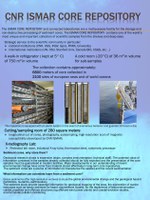Core repository
Collecting marine samples has been, and is, extremely costly. Proper curation and data management can extend the value of marine samples considerably, providing a greater return on the cost of collecting new samples. ISMAR CNR Core Repository host marine sample collections of great importance in ocean research. They are used for research in climate, environment, many other marine geological studies, and for education. The only way to get them is to go to sea by ship. A scientist proposes a study requiring use of deep-sea sediment, and upon approval and award of a research grant, begins plans for a research \"cruise\". These plans begin at least two years in advance, frequently more. There will be many scientists onboard, many technicians to help with coring and shipboard research on the sediment, computer programmers for the databases and data handling, and students. There will also be equipment specific to that particular cruise -- coring gear and supplies, computers, and laboratory equipment. It is a large scale effort to get everyone and all the equipment onboard the ship. The marine sediments accumulated on the ocean floor over millions of years are a memory map of changes in oceanic and atmospheric circulation, biogeochemical cycles as well as climate variability, and provide the most complete and continuous archive for paleoclimate research. The analysis of particular marine sediment properties (“proxies”) offers the potential to reconstruct an array of parameters that responded to or modulated changes in the climate system, to applied studies in resources exploration, in marine hazard, in environmental studies. ISMAR-CNR Cores repository facility is a multifunctional lab operating continously since 1970 and has been included in the European marine samples repositories network EUSEASED in 1999.
Technical information
The marine sediments collection at the ISMAR-CNR Cores Repository comprise cores colletted from 1968 to 2009. As of 2009 it contains over 6720 meters of sediment from 2100 cores collected in the Mediterranean Seas, Atlantic and Southern Ocean. The refrigerated storage room is more than 200 square meters large (Volume 750 cubic meters) Temperature (5°C) and umidity constant, and equipped with a temperature control alarm system. Connected with the repository there is a cold room (-20 °C) of 36 square meters for sediment samples for environmental studies. There is also an area for sediment and rock samples dry storage.
In addition to the repository rooms there are several instruments for conducting and/or assisting with analyses of sea sediment cores such as a core splitter, a magnetic susceptibility logger, X-radiograph, as well as a variety of microscopes, sieves, sampling tools and all traditional sediment lab supplies.
Staff involved
Leonardo Langone, Stefano Miserocchi, Enver Lipparini, Andrea Gallerani





